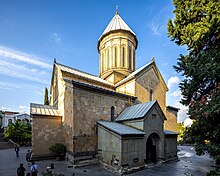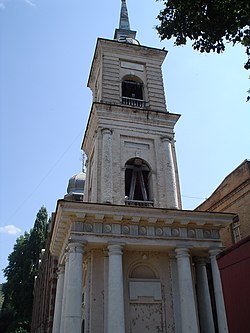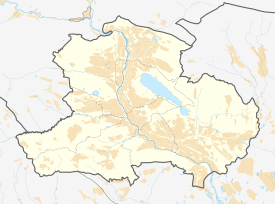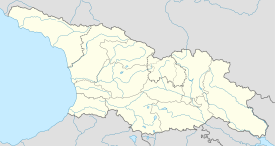Tbilisi Sioni Cathedral
| Cathedral of Saint Mary of Zion სიონის ღვთისმშობლის მიძინების ტაძარი | |
|---|---|
 Sioni Cathedral in september 2023 | |
| Religion | |
| Affiliation | Georgian Orthodox Church |
| Location | |
| Location | 4 Sioni Street, Tbilisi, Georgia |
| Geographic coordinates | 41°41′29″N 44°48′27″E / 41.6914°N 44.8075°E |
| Architecture | |
| Type | Church |
| Completed | Church: 6th–7th century, renovated 13th century and 17th–18th century. Belfry: 1812 |
| Dome(s) | 1 |
| Official name: Sioni Cathedral | |
| Designated | October 1, 2007 |
| Reference no. | 4877 |
| Item Number in Cultural Heritage Portal | 3433 |
| Date of entry in the registry | October 11, 2007 |
| Accounting Card / Passport # | 010404386 |
The Sioni Cathedral of the Dormition (
The Tbilisi Sioni Cathedral is situated in the historic Sionis Kucha (Sioni Street) in downtown Tbilisi, with its eastern façade fronting the right bank of the
History
According to medieval Georgian annals, the construction of the original church on this site was initiated by King
The cathedral was completely rebuilt by King

In 1657, the
The cathedral's interior took on a different look between 1850 and 1860, when the Russian artist and general Knyaz Grigory Gagarin (1810–1893) composed an interesting series of the murals, though a number of medieval frescoes were lost[clarification needed] in the process. A portion of the murals on the western wall were executed by the Georgian artist Levan Tsutskiridze in the 1980s.
The stone
The Sioni Cathedral was where the Russian Imperial manifesto on the annexation of Georgia was first published. On April 12, 1802, the Russian commander-in-chief in Georgia, General Karl von Knorring, assembled the Georgian nobles in the cathedral, which was then surrounded by Russian troops. The nobles were forced to take an oath to the Russian Imperial crown; any who disagreed were taken into custody.[1][2][3]
Sioni Cathedral remained functional through Soviet times, and was partially renovated between 1980 and 1983.
Architecture

The Sioni Cathedral is a typical example of medieval Georgian

Bell towers
| Tbilisi Sioni Old Bell Tower | |
|---|---|
თბილისის სიონის ძველი სამრეკლო | |
Stone | |
| Official name | Sioni Bell Tower |
| Designated | October 1, 2007 |
| Reference no. | 4876 |
| Item Number in Cultural Heritage Portal | 3447 |
| Date of entry in the registry | October 11, 2007 |
| Accounting Card / Passport # | 010404385 |
| Tbilisi Sioni New Bell Tower | |
|---|---|
თბილისის სიონის ახალი სამრეკლო | |
 | |
| General information | |
| Type | Bell tower |
| Architectural style | Neoclassical architecture |
| Completed | 1812 |
| Technical details | |
| Material | Brick |
| Official name | Sioni Bell Tower(New) |
| Designated | October 1, 2007 |
| Reference no. | 4878 |
| Item Number in Cultural Heritage Portal | 3864 |
| Date of entry in the registry | October 11, 2007 |
| Accounting Card / Passport # | 010404387 |
North of the cathedral, within the courtyard, is a freestanding three-story bell tower dating from the 1425 reconstruction by King Alexander I. Largely destroyed by the Persian shah Agha Mohammad Khan Qajar in 1795, it was restored to its present condition in 1939.
Across the street stands another three-story bell tower; one of the earliest examples of Russian

The murals, painted by G. Gagarin, and iconostasis, also designed by him in 1950s-60s, differed from traditional Georgian tradition.
Burials
The Sioni Cathedral serves as a burial ground for several notable churchmen, including the 20th-century Catholicoi-Patriarchs of Georgia, and economic and political figure Giorgi Maisashvili:
- Kyrion II,
- Leonid,
- Ambrose,
- Christophorus III,
- Callistratus,
- Melchizedek III,
- Ephraim II,
- Patriarch David V of Georgia
- Giorgi Maisashvili
- Pavel Tsitsianov
References
- ISBN 1-4021-8908-7, p. 220 (Replica of 1814 edition by Henry Colburn, London)
- ^ Villari, L. (1906), Fire and Sword in the Caucasus, T. F. Unwin, London, p. 32 (Online version [1])
- ^ Lang, DM. (1957), The Last Years of the Georgian Monarchy: 1658–1832, New York City: Columbia University Press, p. 247
- ^ Джанберидзе Н., Мачабели К. (1981) Тбилиси. Мцхета. Москва: Искусство, 255 c.
- ^ Утверждение Русскаго владычество на кавказе, Время Кнорринга, Цицианова и Гудовича. 1801–1809 гг, A. I Liberman: 1901. Volume 1
- Rosen, Roger. Georgia: A Sovereign Country of the Caucasus. Odyssey Publications: Hong Kong, 1999. ISBN 962-217-748-4


